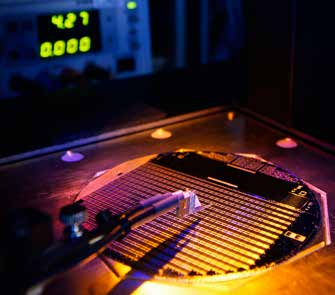Small Cells – Big Effect: III-V High-Efficiency Solar Cells

Multi-junction solar cells are used in concentrator photovoltaics (CPV) in regions with high direct normal irradiation such as South Africa, China or the USA to produce renewable electricity at a low cost. They are primarily used in large power plant parks of up to 100 megawatts. Fraunhofer ISE has been working together with partners for many years to further increase the efficiency of multi-junction solar cells and lower the costs. Multi-junction solar cells are based on a combination of different III-V semiconductor compounds such as gallium indium phosphide (GalnP), gallium indium arsenide (GalnAs) or germanium (Ge). Each of these semiconductors converts a different wavelength range of sunlight into electricity. Together the sub-cells produce a high overall efficiency. III-V multi-junction solar cells were originally used for powering satellites. Fraunhofer also performs research and develops solar cells for space applications.
For terrestrial applications in concentrator photovoltaic plants, III-V multi-junction solar cells are built into modules and then integrated into a complete concentrator system. The III-V multi-junction solar cells are placed at the focal point of optically concentrating lenses – so-called Fresnel lenses – that enable a 500-fold concentration of the light. The concentrator modules are placed on a biaxial tracker that follows the position of the sun throughout the day.
Fraunhofer ISE’s current world record solar cell is a four-junction solar cell. Each of the four sub-cells converts exactly one fourth of the photons in the wavelength range between 300 and 1750 nm into electric energy. A particular challenge which was successfully met with these solar cells was the even distribution of photons on the four sub cells. This was achieved by scientists at Fraunhofer ISE by precisely adjusting the material composition and density to each individual semiconductor layer in the solar cell. The new record level was measured at a concentration of 508 suns, i. e. the 508-fold bundling of incident light.
Together with Soitec Solar, Fraunhofer ISE was awarded the German Environmental Award in 2012 by German President Joachim Gauck for the development, market launch and commercialization of concentrator photovoltaic.
 Fraunhofer Group for Materials and Components - Materials
Fraunhofer Group for Materials and Components - Materials